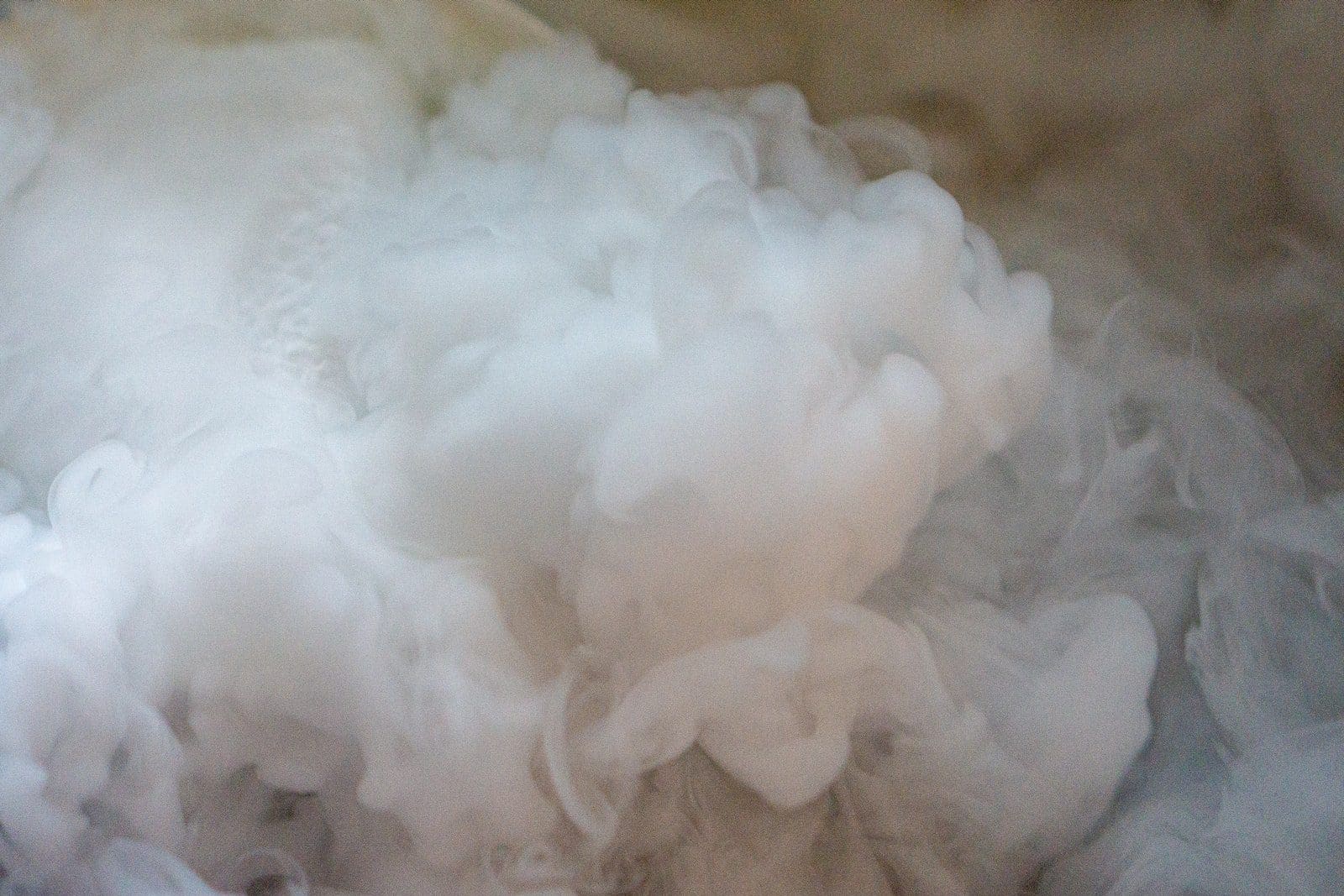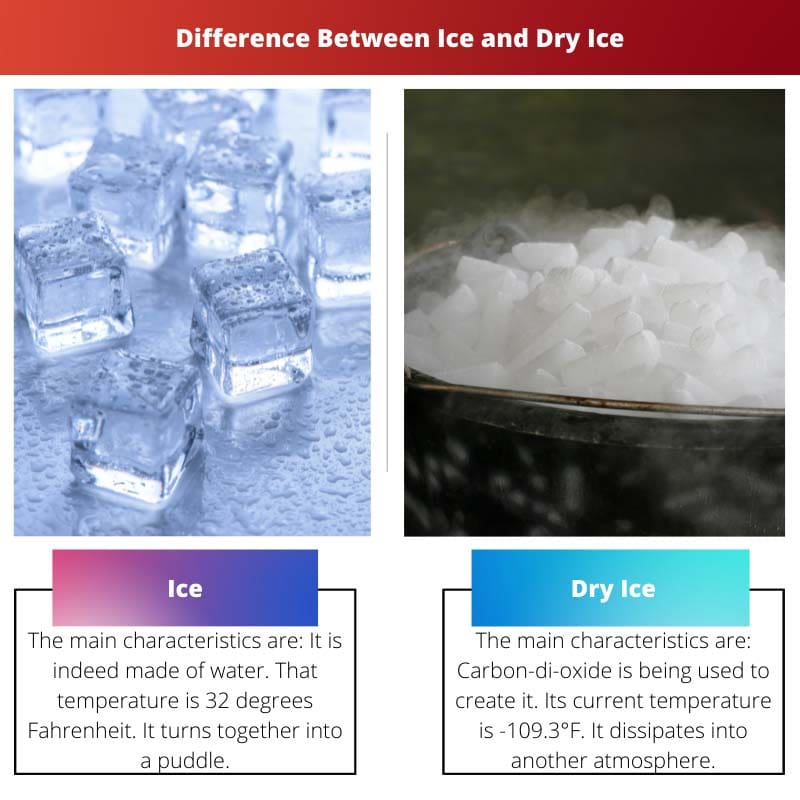Dry ice and ice were two completely different substances with distinct chemical and physical properties.
That significant difference between dry ice and ice is especially relevant for clients who produce and utilize dry ice.
As the year’s dry ice manufacturer, we could not only offer you the best Dry ice pellet machine and dry ice block machine but also thorough dry ice fundamentals.
Key Takeaways
- Ice forms from water at or below 0°C (32°F) and melts back into the water, whereas dry ice is solid carbon dioxide and sublimates at -78.5°C (-109.3°F) without a liquid phase.
- Dry ice has stronger cooling capabilities than regular ice, making it ideal for preserving perishable items and creating special effects.
- Handling dry ice requires caution, as it can cause severe frostbite and needs proper ventilation to prevent the risk of carbon dioxide poisoning.
Ice vs Dry Ice
Ice is the solid form of water that forms when water is frozen at a temperature of 0°C (32°F) or below. Ice is commonly found in nature, such as in frozen lakes, rivers, and glaciers. Dry ice is the solid form of carbon dioxide (CO2) that forms when CO2 gas is compressed and cooled to a temperature of -78.5°C (-109.3°F) or below.

Ice is a solid material formed from chilling water vapour or liquid water.
Water vapour condenses, forming frost near floor level and snowflakes (each consisting of a single ice crystal) in clouds when temperatures fall below 0 °C (32 °F).
Water vapour solidifies below the same temperature as in river ice, sea ice, hail, and ice manufactured professionally or in domestic freezers.
Dry ice has a far larger cooling capacity than ice because it can sustain a high level of efficiency for several hours.
Though that is sometimes necessary to utilize ordinary ice, dry ice may also be included with the job to extend the life of any particular product.
Another significant difference would be that, unlike ordinary ice, which readily dissolves into water, dry ice lasts longer and leaves no residue after use.
Comparison Table
| Parameters of Comparison | Ice | Dry Ice |
|---|---|---|
| Characteristics | The main characteristics are: It is indeed made of water. That temperature is 32 degrees Fahrenheit. It turns together into a puddle. | The main characteristics are: Carbon-di-oxide is being used to create it. Its current temperature is -109.3°F. It dissipates into another atmosphere. |
| Chemical bonds | It consists of a 1 O2 atom covalently bonded to 2 H-O-H. | It comprises of 2 O2 atoms bonded with a single carbon atom. |
| Uses | The main uses are It’s being used to keep beverages chilled. It is utilized to alleviate discomfort inside the afflicted portion of the brain. It’s being used to make ice sculptures. | The main uses are It can be used to create bubbles in beverages including soda and beer. This is used to keep poultry and meat fresh. It has been used to flash freeze food, biological samples in laboratories, as well as to produce ice cream. |
| Chemical structure | The chemical structure of ice is H2O. | The chemical structure of Dry ice is CO2. |
| States | It has three forms of state: Solid-Liquid and Gaseous | It rapidly transitions from just a solid to a gaseous form. This one is referred to as sublimated. |
What is the Ice?
Ice is indeed a natural source of inorganic solids with such a predetermined structure, i.e., it is simply liquid frozen into some kind of solid form.
It’s indeed abundant in nature and is classified as just a mineral due to its uniform crystalline structure. It might even be clear, opaque, or bluish-white in hue.
That is one of the 15 known water phases. There are also other types of ice, such as snowflakes, ice pellets, hailstones, diamond dust, and so on.
Ice was plentiful on Earth, but it may also be generated artificially for a variety of reasons.
Ice may be manufactured and maintained via refrigeration, in which water is chilled below 00 degrees Celsius to form ice.
Commercial ice was extensively utilized for winter recreation as well as a variety of activities such as ice skating, ice hockey, ice fishing, and so on.
Ice also plays an important function in climate change and the water cycle.

What is Dry Ice?
Dry ice, on the other hand, contains carbon dioxide that has been frozen. It’s the concrete version of the aforementioned gas. These are chemically created, yet it is thought to have been abundant on Mars.
Sublimation occurs when high-pressure liquid carbon dioxide immediately transitions from a solid to a gaseous state sans an intermediate liquid state. This leaves no water trace and simply vanishes into the air.
Dry ice, sometimes called card ice, is used to keep things cold. It has a sour zesty scent and is colorless in nature. It is also non-flammable and acidic, with poor electrical and thermal conductivity.
Dry ice is an extremely important chilling agent due to its super-cool characteristics and sublimation method. However, because dry ice is very poisonous and can cause frostbite, it should be handled with extreme caution.

Main Differences Between Ice and Dry Ice
1. The Ice is readily melted by giving heat. But Dry Ice is melted by giving the air pressure.
2. The ice is in the solid form of water. But Dry ice is in the solid form of carbon dioxide.
3. The ice needs a higher temperature to be frozen. But Dry ice needs a lower temperature to freeze.
4. The ice can be easily consumed by humans, but Dry ice cannot be meant for consumption it is dangerous for humans.
5. Ice can be used to cool beverages. But Dry ice is used for cooling in shipping and preserving the goods.

- https://onepetro.org/IJOPE/article-abstract/27837/Droplets-of-Dry-Ice-And-Cold-Liquid-CO2-For-Self
- https://www.mdpi.com/244166

The comparison table provided in the article is very helpful in understanding the differences between ice and dry ice. The chemical structure and states of both substances are explained in a clear and concise manner.
I found the explanation of the chemical bonds and uses of ice and dry ice very enlightening. This article presents valuable information for anyone seeking to understand the fundamental differences between the two.
Absolutely, the chemical and physical properties of ice versus dry ice are well-explained. It’s important to know how each substance behaves under different conditions.
The article presents a detailed examination of the chemical composition and states of ice and dry ice, providing a comprehensive understanding of their unique properties and applications.
Absolutely. The information about the chemical structure and characteristics of ice and dry ice is very informative and well-explained.
The article provides a clear and comprehensive explanation of the differences between dry ice and regular ice. It is important to understand these differences, especially for those who produce and use dry ice.
I completely agree. The detailed information about the characteristics and uses of dry ice is very helpful and informative.
The information about the uses and applications of both ice and dry ice is enlightening. It’s important to understand the distinct cooling capabilities and chemical structures of these substances.
The detailed explanation of the chemical structure and properties of both ice and dry ice is quite enlightening. This article is an excellent reference for understanding the fundamental differences between the two substances.
I completely agree. The comparisons and explanations provided in the article offer valuable insights into the unique characteristics of ice and dry ice.
The distinction between ice and dry ice is crucial, and this article does an excellent job of breaking down the differences. The section that explains what dry ice is and how it differs from regular ice is particularly informative.
I couldn’t agree more. The details about the chemical structures and states of both ice and dry ice provide a deeper understanding of their properties and applications.
The article effectively highlights the chemical and physical differences between ice and dry ice. The comparison table makes it easy to grasp the distinctions between the two substances.
I found the information about the characteristics and uses of ice and dry ice to be very educational. The detailed explanations are valuable for anyone who works with these substances.
This article provides a thorough and scientific analysis of ice and dry ice. It’s a great resource for anyone seeking detailed information on these substances.
The article provides a comprehensive overview of ice and dry ice without oversimplifying the scientific aspects. The section comparing the characteristics and uses of the two substances is particularly insightful.
I agree. The article’s emphasis on the differences in chemical structure and its impact on the uses of ice and dry ice is highly informative and valuable.
The article’s comprehensive comparison of ice and dry ice offers a nuanced understanding of their chemical and physical differences. This scientific analysis is beneficial to anyone seeking detailed knowledge of these substances.
The comparisons between ice and dry ice are truly educational. The explanations of the chemical and physical properties of both substances are thorough and well-presented.
The detailed comparison of ice and dry ice provides valuable insights into the distinct features and applications of both substances. It’s a great resource for understanding their properties.
I couldn’t agree more. The article offers an in-depth analysis of the unique characteristics and uses of ice and dry ice.